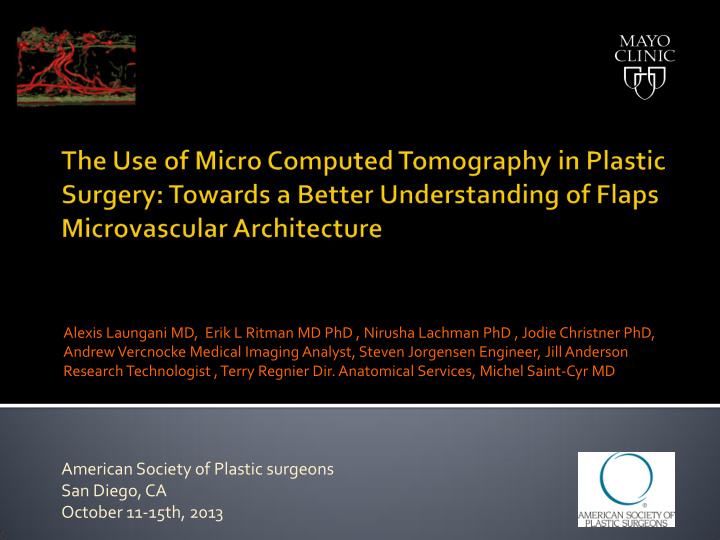



Alexis Laungani MD, Erik L Ritman MD PhD , Nirusha Lachman PhD , Jodie Christner PhD, Andrew Vercnocke Medical Imaging Analyst, Steven Jorgensen Engineer, Jill Anderson Research Technologist , Terry Regnier Dir. Anatomical Services, Michel Saint-Cyr MD American Society of Plastic surgeons San Diego, CA October 11-15th, 2013
No Disclosures
2008: Use of 3D and 4D CT Angiography for flap perfusion investigation 1 2009: Definition of the Perforasome theory 2 , with direct linking vessels and indirect linking vessels (subdermal plexus, also called “choke vessels” by Taylor 3 , Palmer and Morris) Poor resolution of classic CT Scanner for the assessment of the subdermal plexus and flap microvascular architecture USE OF MICRO CT SCANNER 1 Saint-Cyr M, Wong C, Schaverien M, Mojallal A, Rohrich RJ. Three- and four-dimensional computed tomographic angiography and venography for the investigation of the vascular anatomy and perfusion of perforator flaps. Plast Reconstr Surg. 2008 Mar;121(3):772-80 2 Saint-Cyr M, Wong C, Schaverien M, Mojallal A, Rohrich RJ. The perforasome theory: Vascular anatomy and clinical im- plications. Plast Reconstr Surg. 2009;124:1529 – 1544 3 Taylor GI, Palmer JH. The vascular territories (angiosomes) of the body: Experimental study and clinical applications. Br J Plast Surg. 1987;40:113 – 141
Fresh cadavers acquired through the Anatomy Department at Mayo Clinic, Rochester MN after IRB approval First step: Study of the vascularization of a whole region (thigh and abdomen) with AngioCT and Micro AngioCT Second step: Study of the vascularization of perforator flap harvested from the thigh (ALT flap) and the abdomen (DIEP flap) with AngioCT and Micro AngioCT Analysis of the results
Canulation of the Deep Canulation of Lateral Inferior Epigastric Artery at its Circumflex Femoral Artery at origin its origin Injection of Microfil (Flow Tech Inc., Carver, MA) under pressure monitoring, at physiologic pressure of 120-130 mmHg Polymerization of the Microfils during 48 h Harvest of the whole Harvest of the whole abdominal anterolateral thigh region fasciocutaneous flap
Dissection of a hemi-DIEP Dissection of a hemi-DIEP flap flap Cannulation of the largest dominant perforator Injection of Microfil (Flow Tech Inc., Carver, MA) under pressure monitoring, at physiologic pressure of 120-130 mmHg, directly in the cannulated perforator Polymerization of the Microfils during 48 h
AngioCT Scanner of the specimen (Definition, Siemens Healthcare, Forchheim, Germany) Analysis of the images Incorporation of radio-opaque marks on the specimen, in order to define the specimen to be sent for Micro-CTScanner processing Example of a 3D rendering of a classic CT Scanner image (GULF Flap)
Microcomputed tomography (micro-CT) scanner generates three-dimensional (3-D) images consisting of up to a billion cubic voxels, each 5 – 25 μm on a side isotropic spatial resolution The duration of each scan depends on the magnification desired (normally 20 µm cubic voxel but also 10 and 5 µm cubic voxels) Jorgensen SM, Demirkaya O, Ritman EL. Three-dimensional imaging of vasculature and parenchyma in intact rodent organs with X-ray micro-CT. Am J Physiol: Heart, Circ Physiol. 1998;275(3):H1103-H1114
Micro-CT (17µm voxels) * Injected perforator SKIN FAT SKIN FAT SKIN FAT * * Whole abdomen (DIEA injected) DIEP Flap with vessel tracking DIEP Flap (largest perforator injected)
Micro-CT (17µm voxels) Clear visualization of the subdermal plexus (indirect linking vessels) SKIN FAT Direct linking Injected Visualization of 3 adjacent perforators filled by vessel Perforator direct flow through the direct linking vessels and recurrent flow through indirect linking vessels
Application of the technology for a study with direct clinical impact AIM = To study the impact of dermis removal on a DIEP flap before inset of the flap in breast reconstruction (instead of meticulous de-epithelialization) 12 Hemi-DIEP flaps harvested Scanned after contrast injection in the largest cannulated perforator Contrast flushed out and dermis removed with cautery Flap reinjected and rescanned RESULTS: Mean difference in flap perfused percentage = 26%
Injected perforator Perforator filled through indirect linking vessels (recurrent flow) DERMIS & SUBDERMAL PLEXUS Loss of adjacent DERMIS REMOVED F perforator filling DIEP FLAP WITH AND WITHOUT DERMIS
2) Indirect linking vessel 3) Communicating branches SKIN FAT 1) Direct linking vessel Full thigh Vascular architecture is organized in 3 main components: 1) Deep at the level of the subcutaneous fat: direct linking vessels 2) Superficial at the level of the skin : subdermal plexus (indirect linking vessels) 3) Communicating branches between direct and indirect linking vessels
ALT Flap
Advantage: High Voxel definition Visualization of microvascular structures (cf. subdermal plexuses in flaps) Inconvenient : Small specimen (max size 2cm x 2cm x 2cm per scanner) Expensive: $350/scanner Requires a trained team (engineers, analysts) New tool in flap perfusion research, with clinical impact (cf. DIEP flap perfusion and dermis removal)
Recommend
More recommend